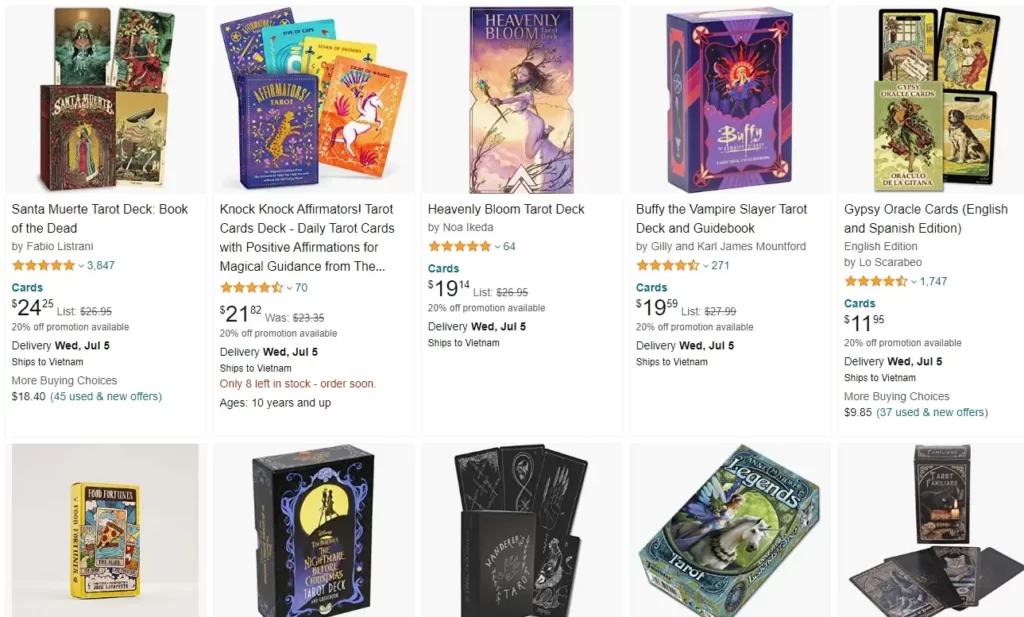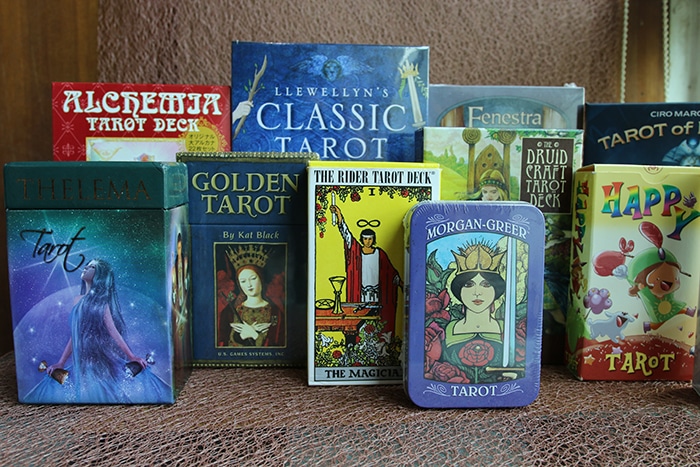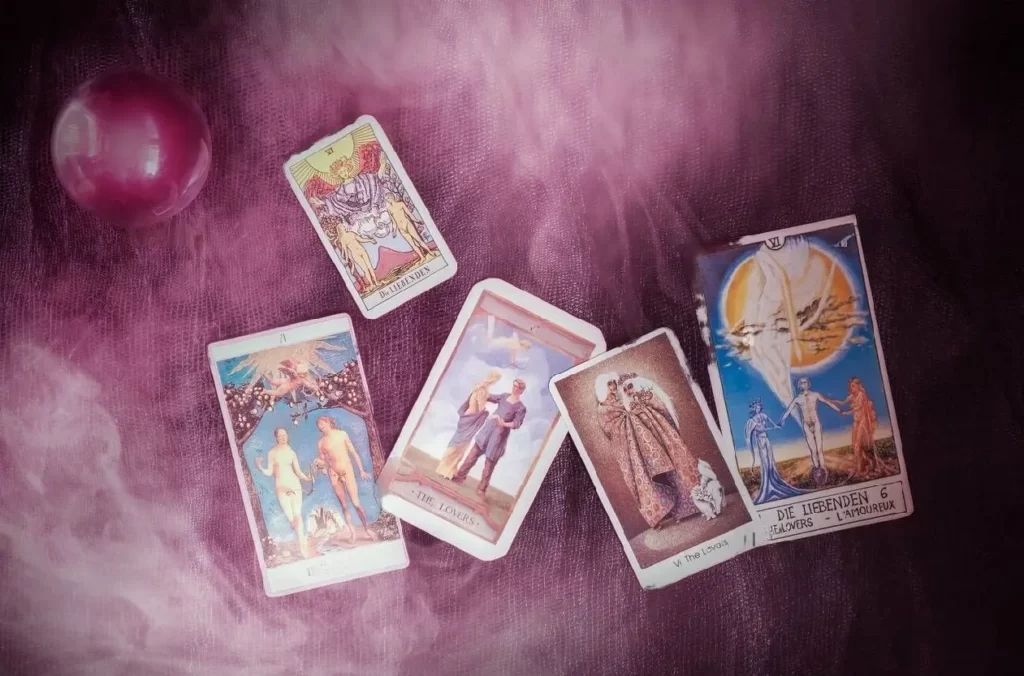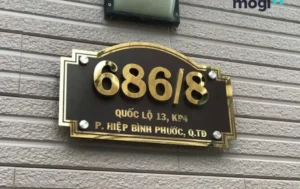In recent years, the ancient art of Tarot reading has experienced a renaissance, reaching an increasingly diverse and global audience. While once viewed as the province of the mystically inclined, Tarot has transcended its esoteric origins, appealing to individuals seeking personal insight, spiritual growth, and a deeper connection to their intuition. With this surge in popularity, the number of Tarot decks available in the market has grown exponentially, presenting an array of themes, artistic styles and interpretative systems.
Choosing the right Tarot deck is a significant step in your journey with this transformative tool. The deck you work with forms the foundation of your relationship with Tarot; it is the bridge between your intuition and the universal wisdom Tarot encapsulates. A well-chosen deck resonates with you personally, enhancing your understanding of the cards and fostering a deeper intuitive connection during readings.
This article aims to guide you in choosing a Tarot deck that aligns with your aesthetic preferences, interpretative needs, and spiritual aspirations. It will navigate you through the diversity of Tarot decks, key considerations when choosing a deck, popular decks for beginners, places to purchase a deck, and tips for trying out different decks over time.
Understanding the diversity of Tarot decks
The world of Tarot cards is as diverse as it is intriguing, with a multitude of decks each offering a unique lens through which to interpret and understand the messages of the cards. The vast array of decks can be broadly categorized into traditional, modern, and thematic Tarot decks, each with its distinctive characteristics and appeal.
Traditional Tarot Decks are often based on the Rider-Waite-Smith system, one of the most popular and enduring systems in Tarot. Traditional decks like the Rider-Waite-Smith Tarot Deck or the Crowley-Harris Thoth Tarot Deck, are rooted in the rich symbology and structure of classical Tarot, making them an ideal choice for those interested in historical context and established interpretative frameworks.
Modern Tarot Decks, on the other hand, offer contemporary interpretations and illustrations of the Tarot’s archetypal themes. These decks often present more inclusive, diverse, or updated imagery, reflecting modern perspectives and experiences. Some popular modern decks include the Wild Unknown Tarot Deck and the Modern Witch Tarot Deck. These decks can be an excellent choice for individuals seeking a deck that resonates with contemporary sensibilities.
Thematic Tarot Decks are a varied category encompassing decks centered around a specific theme, artistic style, or concept. These can range from fairy tale-based decks, animal-inspired decks, to those revolving around specific cultural, philosophical, or spiritual systems. Thematic decks like the Cat Tarot or the Mythic Tarot can appeal to individuals drawn to a particular theme or aesthetic.
Each of these categories of Tarot decks presents a unique flavor of symbolism, artistry, and narrative, thus influencing the tone and nuances of a Tarot reading. Understanding the diversity of Tarot decks is a crucial step in choosing a deck that aligns with your personal preferences and Tarot reading goals.
Factors to consider when choosing a Tarot deck
Selecting a Tarot deck is a deeply personal decision that goes beyond mere aesthetic appreciation. It involves considering several factors that can influence your connection with the deck and your subsequent Tarot readings. Let’s delve into some of these key considerations.
Personal resonance and intuition: Above all, a Tarot deck should resonate with you on an intuitive level. Spend some time browsing different decks and notice your reactions to the images, colors and overall style. Does a particular deck draw you in? Do the images stir something within you? Your intuitive responses to a deck are often the most reliable guide in choosing a Tarot deck that you will connect with.
Imagery and symbolism: The imagery and symbolism of a Tarot deck play a critical role in your interpretation of the cards. The pictures should be clear and engaging, provoking thought and allowing you to delve into the symbolic messages. If the artwork is too abstract or confusing, it may be challenging to decipher the card’s meaning, especially for beginners.
Ease of understanding: For those new to Tarot, a deck that closely aligns with traditional Tarot systems, such as the Rider-Waite-Smith, can be easier to understand and learn. These decks usually come with comprehensive guidebooks and are widely discussed in various Tarot resources, which can be particularly helpful for beginners.
Quality of the deck: Consider the physical attributes of the deck. The quality of the card stock, the size of the cards, and the legibility of the images and text all contribute to the ease and enjoyment of using the deck. Furthermore, some decks come with accompanying guidebooks or materials that provide additional insights into the deck’s unique features or the creator’s interpretative approach.
Choosing a Tarot deck like a trusted companion on your Tarot journey, a tool that speaks to your intuition and enhances your understanding of the Tarot’s wisdom. Therefore, take your time, trust your instincts, and enjoy the process of discovering your ideal Tarot deck.
Recommendations for first Tarot decks
Choosing your first Tarot deck can be both an exciting and overwhelming experience due to the vast array of options available. Certain decks, however, are particularly well-suited for beginners due to their accessible imagery, comprehensive guidebooks, and alignment with traditional Tarot structures. Here are a few recommended Tarot decks for beginners:
The Rider-Waite-Smith Tarot Deck: The Rider-Waite-Smith Tarot is arguably the most widely recognized and used Tarot deck worldwide. Created by Arthur Edward Waite and Pamela Colman Smith, this deck is renowned for its clear and detailed imagery, abundant symbolism, and alignment with traditional Tarot structure. The Rider-Waite-Smith deck serves as the basis for many modern Tarot interpretations, making it a solid choice for beginners.
The Morgan-Greer Tarot Deck: The Morgan-Greer Tarot is a colorful and vibrant deck based on the Rider-Waite-Smith system. The deck’s lush, full-bleed art creates an immersive experience, and the absence of borders on the cards allows for a seamless flow of imagery and symbolism. Its detailed, easily interpretable images make it another excellent choice for beginners.
The Easy Tarot Deck (Gilded Tarot): The Easy Tarot Deck, featuring the striking Gilded Tarot, is a beginner-friendly kit that includes a beautifully illustrated deck and an accompanying guidebook. The guidebook provides straightforward explanations of the cards and offers simple spreads to get you started with Tarot readings.
The Radiant Rider-Waite Tarot Deck: The Radiant Rider-Waite Tarot is a reimagined version of the original Rider-Waite-Smith deck, with updated colors for a more vibrant, contemporary feel while maintaining the traditional symbolism and imagery.
LotusBuddhas would like to remind you that, while these decks are beginner-friendly, the best deck for you is one that resonates with you personally. Explore these options, and see if any of them connect with your intuition and aesthetic preferences. Whichever deck you choose will serve as a guide and companion on your Tarot journey, assisting you in uncovering the wisdom and insights that Tarot has to offer.
Where to buy Tarot decks
With the growing popularity of Tarot, finding a place to purchase a Tarot deck has never been easier. However, it’s crucial to ensure that you’re buying from reputable sources that guarantee the quality and authenticity of the decks.
Local bookstores and metaphysical shops: These are traditional sources for purchasing Tarot decks. Metaphysical shops often have a broader selection of decks, and you have the added benefit of physically seeing and feeling the deck before purchasing. Some bookstores also carry a selection of popular Tarot decks.
Online retailers: Websites like Amazon and eBay offer a wide range of Tarot decks from various publishers. They allow for easy comparison of prices and user reviews, which can provide additional insight into a deck’s quality and usability. Be sure to verify the authenticity of the deck and the reliability of the seller when buying from these platforms.
Specialty Tarot retailers: These are online stores specifically dedicated to Tarot and Oracle cards. Examples include The Tarot Garden and Llewellyn Worldwide. These retailers often provide comprehensive information about each deck, including card dimensions, publisher information, and a brief overview of the deck’s theme and style.
Independent artists and creators: Many artists and Tarot creators sell their decks through personal websites or platforms like Etsy. Purchasing from these sources can be a great way to support individual artists and find unique, non-mainstream decks. Make sure to check reviews and seller ratings when purchasing from these sources.
Regardless of where you choose to purchase your Tarot deck, you have to always check reviews, read product descriptions carefully, and understand the return policy. This way, you can ensure that the deck you receive will be a valuable tool on your journey into the realm of Tarot.
Trying out different decks
As you delve deeper into your Tarot journey, you may find that working with different decks enhances your understanding and appreciation of Tarot’s rich symbolism and diverse interpretative possibilities. Trying out various decks can offer fresh perspectives, challenge your interpretative skills, and keep your Tarot practice engaging and dynamic. Here are some tips for exploring different Tarot decks:
Start with a baseline deck: Especially for beginners, starting with a widely recognized and studied deck such as the Rider-Waite-Smith provides a solid foundation in traditional Tarot symbolism and structure. It serves as a reference point against which you can compare and understand other decks.
Expand gradually: Once you’re comfortable with your baseline deck, consider branching out to other decks that interest you. You could explore a modern deck that presents contemporary interpretations of Tarot themes or a thematic deck that aligns with a specific interest or aesthetic preference.
Use different decks for different readings: Some readers find that certain decks lend themselves better to specific types of readings. For instance, you may find a particular deck resonates more with personal growth inquiries, while another may be more suitable for practical or relationship-oriented questions. Experimenting with different decks for different readings can deepen your understanding of each deck’s unique strengths and character.
Reflect on your experiences: After working with a new deck, take some time to reflect on your experience. Did the deck’s imagery and interpretation enhance your understanding of the Tarot? Did it resonate with your intuition and reading style? Your reflections can guide your choices as you continue to expand your Tarot deck collection.
Remember, the goal of trying out different decks is not to amass a large collection, but to enrich your Tarot practice. Each deck has its unique voice and perspective, and working with a variety of decks can offer a more nuanced and comprehensive understanding of the versatile wisdom of Tarot.
Taking care of your Tarot deck
Respecting and caring for your Tarot deck is essential for maintaining its physical condition and preserving its energetic integrity. Proper care of your deck can contribute to more accurate and meaningful readings.
Storage: Always keep your Tarot deck in a clean, safe place when not in use. Many decks come with a box designed specifically for storage. If not, consider getting a cloth bag or wooden box to protect your deck. Some individuals prefer silk cloths, associating the material with positive energy and protection.
Cleaning: Physically, cleaning your Tarot deck usually involves gently wiping the cards with a soft cloth to remove any dust or dirt. Energetically, it can involve practices like passing the cards through sage smoke or placing a clear quartz crystal on top of the deck with the intention of clearing any negative energies.
Handling: Handle your cards with respect and mindful intent, as your energy interacts with the deck during shuffling and reading. Ensure your hands are clean before touching your cards to prevent oils or dirt from damaging the cards.
Shuffling: Be gentle when shuffling your cards to avoid damaging them. There are many ways to shuffle, and not all methods suit all people or all decks. Find a method that works well for you and your deck.
Bonding with your deck: Spend time with your new deck. Look at each card and notice its imagery, symbolism, and the feelings it invokes in you. This bonding process aligns your energy with the deck, leading to more intuitive and insightful readings.
Rotation: If you own multiple Tarot decks, rotating them can help prolong their life. It also gives you the opportunity to connect with different decks and appreciate their unique qualities.
Taking care of your Tarot deck not only honors the deck itself but also the spiritual journey you’re undertaking. The more respect and care you give your deck, the more wisdom and insight it can provide in return.
Conclusion
The journey of choosing the right Tarot deck is deeply personal and unique to each individual. There is no one-size-fits-all deck, and the ‘right’ deck differs for everyone. It is a voyage of self-discovery that invites introspection and cultivates intuition.
While factors such as artistic style, thematic resonance, deck structure, and creator’s vision are important, the key consideration is how deeply you connect with the deck and how effectively it aids in unlocking your intuitive potential.
In conclusion, selecting the right Tarot deck requires mindful consideration, but ultimately, it is your intuition that serves as the best guide. Take your time, explore your options, and open yourself to the transformative experience that Tarot offers. Remember that, the deck that you’re meant to work with is the one that will resonate with your inner truth and become an integral part of your journey of self-discovery and personal growth.
You can also refer more:
- How to read Tarot cards for beginner: https://lotusbuddhas.com/how-to-read-tarot-cards-for-beginner.html
- The meaning of Major Arcana cards in Tarot: https://lotusbuddhas.com/the-meaning-of-major-arcana-cards-in-tarot.html
- The meaning of Minor Arcana cards in Tarot: https://lotusbuddhas.com/the-meaning-of-minor-arcana-cards-in-tarot.html
- The meaning of reversed Tarot cards: https://lotusbuddhas.com/the-meaning-of-reversed-tarot-cards.html











